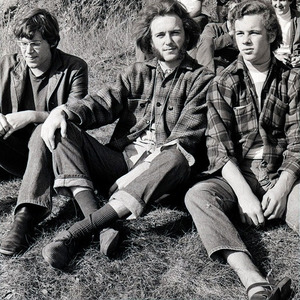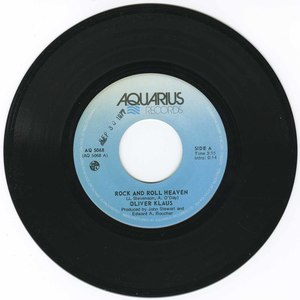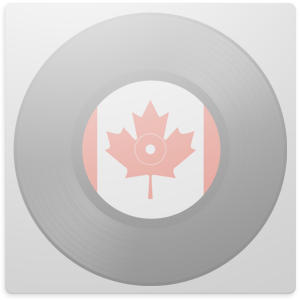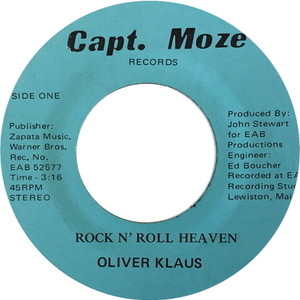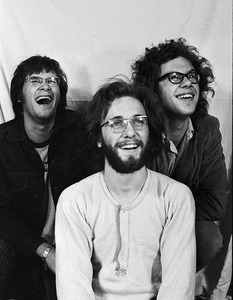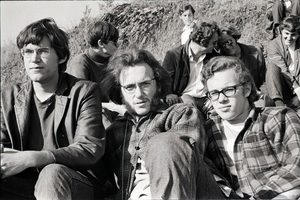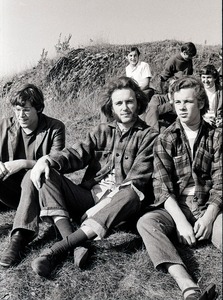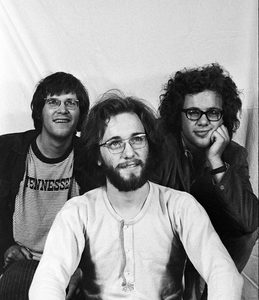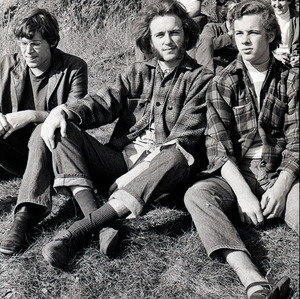Oliver Klaus
Websites:
https://www.psychedelicbabymag.com/2019/09/oliver-klaus-interview.html
Origin:
Waterloo, Québec
Biography:
Oliver Klaus earned a place in Canadian rock and roll history by recording, pressing and distributing their own LP in 1970. The Oliver Klaus album is arguably the first “do-it-yourself” rock and roll LP in Canada and possibly the US, a herald to the DIY punk rock attitude that became prevalent much later in the decade.
What makes this story even more surprising is that the band members were between 18 and 20 years old at the time. Brothers Maurice Singfield (guitar, vocals) and Bryan Singfield (drums, vocals) were seasoned musicians by then, having already played together in four groups since their first band in 1964-65. Still unsigned, they live in Waterloo, Quebec where they perform, write and produce their music. Maurice has received an award from the Governor General of Canada and the Canada Council for the Arts, for two of his original compositions: “You’ve Got a Land” (1992) and “Eastern Townships Land” (1972).
Maurice Singfield of Oliver Klaus shares his story.
Where and when did you grow up?
I was born in 1950 and my Brother Bryan in 1952 and we grew up in the Eastern Townships of Quebec, in the small town of Waterloo (population – 3500). Jerry Cushen was from Fulford, Quebec, also in the Townships and it was a village with only a few hundred people, maybe less.
Was music a big part of your family life?
My family wasn’t a musical family, so to speak. My mother and my father didn’t play an instrument and there was no musical education offered at school. My mother recognized that I had an ear for music because I could pick out chords on the piano and compose melodies at an early age. I was around 8 years old at the time. When I was 15 I became interested in the guitar and my parents bought me one. Gradually I became acquainted with the instrument and started learning chords and some pop tunes, mainly Beatles’ tunes; they were all the rage at the time and my mother fed us (me and my brother Bryan) Beatles’ records and magazine articles which encouraged us to form a band.
When did you begin playing music?
Started playing music with my brother and local musicians when I was 15. Bryan was 13.
What was your first instrument?
Guitar. I only doodled on the piano when I was younger.
Who were your major influences?
The Beatles, Jimmy Hendrix, Cream, The Grateful Dead
What bands were you a member of prior to the formation of Oliver Klaus?
Only one band with my brother Bryan (we always played together), a French band called Les Notables.
Can you elaborate the formation of Oliver Klaus?
We were what was called at the time, a power trio; guitar, bass and drums. I played guitar, my brother the drums and Jerry Cushen (a high school friend) played bass. Before Jerry joined the band, as bass player in 1969, we had another friend of ours, Graham Worden, play bass with us from 1967 to ’68.
How did you decide to use the name ‘Oliver Klaus’?
I come from a family of five boys and it was my older brother Norman who suggested the name. Oliver Klaus is my middle name (my mother was German – a war bride – and my father French Canadian) and at the time it was common to have the main members of bands use their names as a group moniker. Also it sounded different from other band names.
When and where did Oliver Klaus play their first gig?
That’s a difficult question to answer. It was so long ago. It probably was a school in Granby, Quebec in 1967.
Do you remember the first song the band played? How was the band accepted by the audience?
No, I don’t remember the first song we played or the audience reaction. However, I remember being very nervous on stage at the beginning of our so-called career. I was always writing songs and preferred working on our own tunes before covering well known artists. It was common for us to last no longer than a week in a new club because we didn’t play enough popular music. Gradually we found that 50% original music to 50% covers worked well for us.
What sort of venues did Oliver Klaus play early on?
We played high schools, community centers, outdoor events, arenas and bars /clubs.
“At the time improvisational rock was very popular” Where were they located? What influenced the band’s sound?
The venues were located in the Eastern Townships, Montreal and Quebec city areas. The outdoor venues were the most fun and usually provided larger audiences such as Man and His World (Expo “67) in Montreal and the Quebec city boardwalk.
At the time improvisational rock was very popular, long jams that would go on for 15 to 20 minutes and interesting arrangements of popular songs. It was the music scene at the time that influenced us. The daring attitude of improvising, not knowing where we would end up musically on stage. Also, the psychedelic effects of distortion, feedback and tape echoes inspired us to reach further into the unknown. Our shows were always very spontaneous. I don’t think we relied too much on set lists. Of course we used the sounds of the day, provided by great artists, as a sort of blueprint to follow.
We also had a light-rock side to us which came out mainly in the original compositions. Our first album (self titled) had an “A” side of originals and a “B” side of jammed out popular tunes recorded live.
What was the local scene? Any other bands worth mentioning?
The local scene in the late 60s and early 70s was emulating the world-wide trend in rock at the time; drugs, long guitar and drum solos. What we did was mix it up with melodic originals. Other local bands that we shared the stage with were also into pop sounding tunes as well. There was Mashmakan, April Wine, The Haunted to name a few. It was a good time to be in a band. There was a lot of work. We actually got paid to play. “Years later we were credited as being the first rock band in Canada to release an album independently and arguably before any band did in the USA at that time.”
Was your album privately released? What’s the story behind your debut album? Where did you record it? What kind of equipment did you use?
We released our album independently. We built our own recording studio in Waterloo in the basement of a restaurant where we practiced. We scrounged second-hand construction materials and purchased used mics, a tape deck and a console from a local radio station. With little knowledge of recording we managed to record an album with what we had and got it mastered in Montreal at the RCA studio. For the “B” side of the record we used only four microphones to record a live show at the Waterloo arena. We used two Sony C38 mics as a stereo pair at the front of the stage, for capturing the band’s instruments, and two shure mics for the vocals. Behind the stage a couple of our friends monitored the levels of a TEAC tape deck and Grommes tube mixer we acquired from the radio station. The studio side of the album was recorded with the same equipment. We had picked up a bunch of used cement blocks from a construction site and built a sound proof wall by filling the holes in the blocks with sand. We installed a window using three plates of glass at off angles and found an old piece of roofing tin to use as a plate reverb. I screwed a contact pickup to the tin sheet and plugged it directly into our console. I hung the sheet on a pipe running along the ceiling in our basement studio. When we went to do our vocal tracks we stood about five feet in front of the piece of metal singing directly into it. It worked great. That piece of tin was special. When scavenging for material in a scrapyard I noticed a reverb sound coming from a pile of junk when I was speaking with a friend. I stopped and shouted, and sure enough my voice reverberated as if I was in a reverb chamber. I found a sheet of roofing material that was creating the effect. I pulled it from the junk pile and the rest is history. When we moved out of our studio and into a studio I built in my house, I through the sheet away thinking that I could replace it easily by purchasing a new piece. Much to my chagrin I was unable to reproduce the sound of that original piece of roofing tin. Years later we were credited as being the first rock band in Canada to release an album independently and arguably before any band did in the USA at that time.
How many copies were produced? Who was the producer?
We pressed 500 copies. In the late 90s, Frank Manley of No Exit Records out of Montreal re-released the album on vinyl and CD (500 copies each). I was the producer and recording engineer.
How many hours did you spend in the studio?
We spent just about all of our spare time in the studio jamming out songs and recording. It was our private practice room.
Please share your recollections of the sessions.
Recording sessions were social events. Often we had friends hanging out with us (we had a sofa and chairs in the studio). Some would join in on the fun; backing vocals, guitar parts etc.. I would record friends as well (some were singer/songwriters). It was a small vibrant musician’s scene in Waterloo. Recording was no easy feat in those days. The band recorded live, mostly without the vocals first, and later did a sound on sound mix, overdubbing the voices. I had a Roberts tape deck that would play the stereo music track, recorded originally on the TEAC machine, back through the console and the singers would monitor it with headphones while singing along to the track. I had to place the 4 mics I had strategically in the room to capture the sound the best possible way. This would be done without me playing guitar. I would balance the bass and drums and imagine what level I would have to play my guitar at once I joined the group. When I had things set I would press the record button, leave the monitoring booth, close the door behind me, strap on my guitar and find the right level for my guitar by playing a bit with the band. After that we would play the song without vocals and hope for the best. The recorded track would later be mixed through the console along with the vocals as explained above. The console didn’t have EQ for each mic input, there was only a bass and treble knob on the master output. It was the same for the vocal overdubs. I would leave the booth and take my place in front of a mic and put my headphones on to do the vocals. Also we didn’t have any direct inputs for bass and guitar. Everything was recorded with the four mics we had.
What were the influences and inspirations for the songs recorded? Would you share your insight on the albums’ tracks?
The “A” side (studio recordings) were songs that reflected our rural experience: “Here Comes the Sun” was born out of an all night campfire party we had on a mountain side outside of Waterloo. As the sun came up I was inspired to write the song. “For the Boys” tells the story of when the band, along with friends, ran a restaurant with a dance hall on the shores of Brome Lake in the the Townships. It was situated right across the lake from a famous rock club called the Terrace Inn. We dreamed of playing there one day but couldn’t get a booking at the time, so we decided to run our own place. We called it the Other Side restaurant and attracted our own scene for one summer in 1970. Later we finally got to play the Terrace Inn and became the house band for at least four years, coming back from time to time years later. “Walk in the Night” was a song I wrote for a friend of mine. He used it in a school project. It was about indigenous people and their relationship to the land. “Sunny Day, Feeling Groovy” and the “Traveling Song” were written as positive outdoor experiences. We often gathered by lakes, rivers and streams with friends and played music, enjoying the sunshine and mother nature. Side 2 is a complete reflection of the concert scene at the time. Although we did play our originals we were liked for our covers and extended jams.
What can you tell us about the cover artwork?
The cover photo was taken by Marc Jolin, a friend of ours. For the cover he made a high contrast print and another friend, Daniel Racine, did the artwork for the album. The photo was shot at the same location that Here Comes the Sun was written, just outside of Waterloo on a hillside.
Were you inspired by psychoactive substances like LSD at the time of writing the album?
Everyone was experimenting with psychedelics at the time. I can’t say that I was inspired by them. If I was stoned when recording I was never really impressed with the result the day after. I can’t deny the fact that it was all part of the scene and in a way lent itself to our work. Live performances were often done while on weed but not usually on LSD or drugs of that nature.
How pleased was the band with the sound of the album?
When the time came to have the album pressed at the RCA studio in Montreal the engineer at the studio told us that the “A” side was out of phase. Unfortunately it had to be mixed into mono and bass EQ neede to be added to make up for lost frequencies. Needless to say we weren’t too pleased with the result.
I had not much experience as a sound engineer and for some stupid reason I had mixed up the output cables of the left and right channels of the console when doing overdubs. There was no way we were going to do everything over again so we let it go as it was. The thing is, the tracks sounded good in stereo, but when mixed into mono the original master was missing the low end. I still have the original master and plan on playing it to see if it still passes the test of time.
As far as the “B” side is concerned everything sounded great to us. The fact that the whole band was picked up by just two main mics (plus two vocal mics) is amazing to me. It was not affected by a phasing problem as it was a simple direct to stereo live recording.
What, if anything, would you like to have been different from the finished product?
Having had the album recorded in a professional studio. However, I don’t think we would have captured the raw energy of our band if we had of.
What happened after the band stopped?
The band never really stopped. Today we have Bryan and myself still in the line up. We put on shows from time to time and Jerry passed away several years ago. We still produce and record our own material and live in Waterloo. In the late 90s we released an album called Homeless. It was also an independent release produced and engineered by me with whatever equipment was available. Actually we still had the same Sony mics that we used on the first album. Since the first album I took a recording arts and sciences course in Montreal. We both have jobs, Bryan is an accountant and I am a piano tuner. We both have families – wives and children.
Is there any unreleased material?
There is lots of unreleased material.
What currently occupies your life?
My family, my business, a community music TV show that I have been producing for more than 12 years, and songwriting and producing.
-Klemen Breznikar
